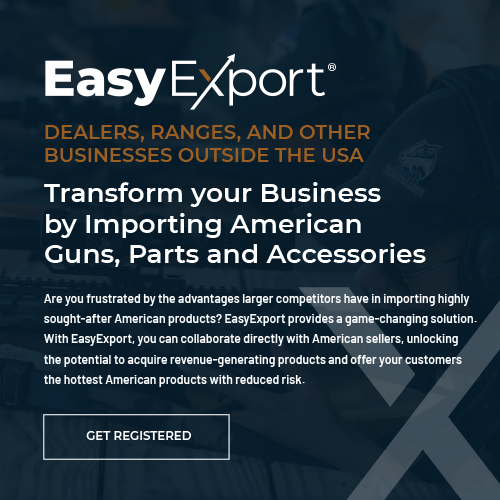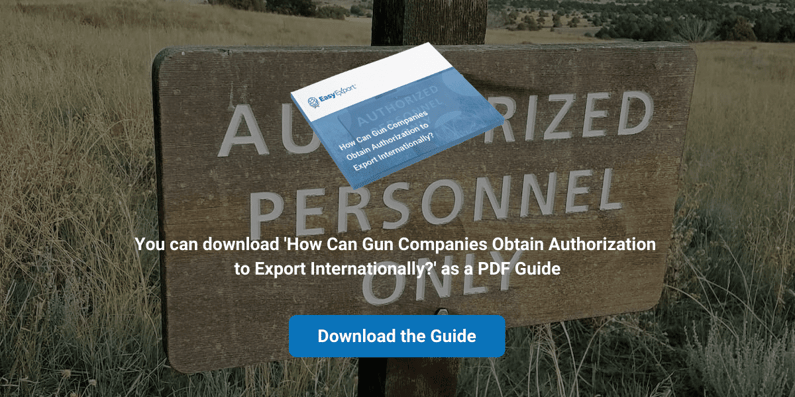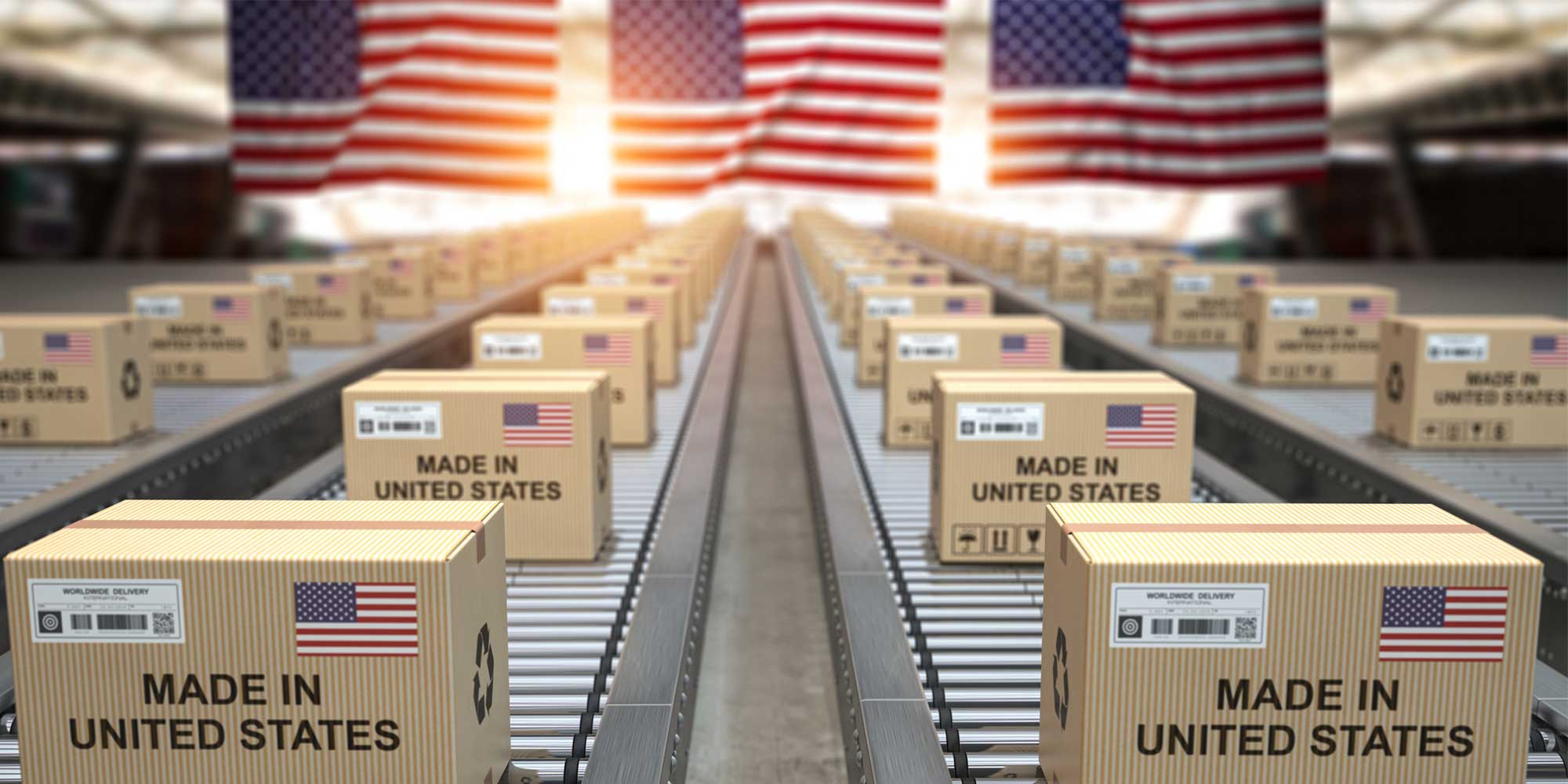If you sell guns, parts, or riflescopes and want to expand your business by selling in international markets, you probably already know that you may need official government authorization to ship your products to other countries.
Export of many of these items is controlled by the Export Administration Regulations (EAR).
It’s important to note that authorization to export guns, parts or riflescopes can take different forms. Sometimes, an export license is required, but other times the EAR authorizes you to export without an export license.
If you plan to handle authorization and export licenses yourself, it’s important to ensure enough resources are available to manage your applications efficiently and competently, as the consequences for getting it wrong can be severe.
What type of authorization do you need?
The type of authorization required to export firearms from the USA will depend on the exact nature of the goods being shipped. As the exporting party, you’re responsible for determining what that authorization is.
You’ll first need to confirm that the goods to be exported are subject to the Export Administration Regulations (EAR) and not the International Traffic in Arms Regulations (ITAR).
If EAR authorization is required, you’ll then need to determine the sort of permission you’ll need before shipping firearms overseas.
Nearly all civilian guns and their components, as well as riflescopes and ammunition intended for civilian use, are subject to the EAR. Sound suppressors however fall under the ITAR.
Generally speaking, items intended primarily for military us (such as automatic weapons) are subject to the ITAR.
The key question to ask yourself is whether you need an export license, or does the EAR authorize you to export without an export license? Knowing the correct answer is critically important if you want to build a lawful export business.
As the exporter, you’re responsible for making this determination, or for filing a formal request for a determination to be made on your behalf when you are unable to make it yourself.
How to determine the type of authorization required
1. Check if your product is subject to the ITAR
To determine whether the product you want to export is covered by the ITAR, you need to check the United States Munitions List (USML). If the product is a gun, gun part, or accessory, look first at Categories I and II of the USML.
If the product relates to ammunition, look at Category III. Other types of military products may be listed in other categories.
If your product is listed on the USML, it is subject to the ITAR. Items that are on the USML fall under the jurisdiction of the ITAR, even if they also appear to be subject to the EAR.
Unless an exemption applies, an ITAR export license, issued by the State Department, will be required.
2. Determine if your product has an ECCN
If the product awaiting export doesn’t appear on the USML, it is subject to the EAR. Being subject to the EAR doesn’t mean you need an export license, however.
It just means that you must look to the EAR to determine whether an export license or other export authorization is necessary.
Check whether your product is listed on the Commerce Control List (CCL) as a first course of action.
This is the official list of products that require authorization before they can be exported. If your product is listed on the CCL, export authorization is required.
Keep in mind that “authorization” doesn’t necessarily mean that an export license is required, (you can for example export a shotgun to one of 30 countries that EAR permits without a license).
The CCL uses a five-character alphanumeric code known as Export Control Classification Numbers (ECCNs).
An alphabetical index of ECCNs can be found here.
If the item in question has an ECCN, authorization is required before you can export it. Most products do not have an ECCN, so don’t be surprised if you can’t find the product you want to export. That’s good news.
That means your product is classified as EAR99 and authorization to export is not required, except in rare circumstances.
3. Decide if your export requires an export license
Even with an ECCN number in hand, you shouldn’t assume that you need an export license.
The requirement for obtaining firearms export licenses depends on several factors:
- The “reasons for control” listed in the applicable ECCN
- The destination country
- The type of end user
- The nature of the end use, and
- The total value of the items being shipped.
When you have all that information, your next step is to review the Country Chart. That’s your second-to-last stop in determining whether you need an export license before sending firearms from the USA overseas.
The Country Chart has a column for each reason for control listed at the top of the applicable ECCN. Look for the row for the country you will be shipping to.
If there are no Xs in the columns for the applicable reasons for control, your export is authorized without an export license.
If there is an X in one or more applicable columns, you do need an export license.
Maybe.
Even when the Country Chart says you need a license, this isn’t always the case.
The EAR contains many license exceptions, such as when the value of the shipment is below the threshold stated in the ECCN.
Be aware that there are many other exceptions and complex requirements.
 4. Check if your export requires additional authorization
4. Check if your export requires additional authorization
Some exports require additional authorization from agencies other than the U.S. Commerce Department or State Department.
If you wish to export sound suppressors, automatic and short-barreled rifles or shotguns for example, you will require an ATF Form 9 before export. You can only apply for this form after you obtain your export license.
If you are exporting to a person or entity subject to U.S. Treasury Department (OFAC) sanctions, you will likely require Treasury Department authorization.
Do it yourself or use a third party
Determining what authorization you need, if any, is complicated and time-consuming. If you make a mistake, you’re responsible.
If your export requires an export license, applying for and managing export licenses entail their own complexity.
If this sounds like an onerous, complex, and time-consuming route, it is.
Therefore, managing exports yourself can require a great deal of your time prior to exporting firearms from the USA.
It’s important to ensure enough resources are available to manage the export process efficiently and without error if you do wish to go down this route, as the consequences for getting it wrong can be severe.
Managing the export process yourself means that responsibility for:
- Determining when an export license is required
- Applying for export licenses
- Obtaining copies of import permits
- Seeking other required authorizations, if any
- Screening end users for sanctions
all falls to you.
If this sounds like too much for you, it doesn’t need to be.
There is another option.
A service like EasyExport gives you the ability to handle the export process in house, be confident that you are operating legally and compliantly and to retain the profit margin you would otherwise pay to an exporter to handle international sales for you.
Using custom-built software, experts can classify your products, determine when export licenses are necessary, apply for licenses, keep track of them, approve import permits, vet your customers, and do everything else necessary for your business to grow internationally.
As the software automates much of the process there is less demand on your internal resources.
You can easily see when the process is complete, and ship orders when they are ready without having to wade through lots of complex paperwork and processes, or budget for an export company to work alongside you.








